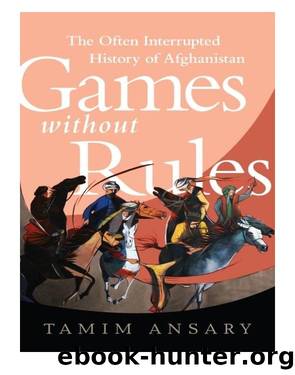Games without Rules by Tamim Ansary

Author:Tamim Ansary
Language: eng
Format: epub
Publisher: PublicAffairs
Published: 2012-10-09T16:00:00+00:00
PART IV: OLD AFGHANISTAN ERUPTS
Nadir Shah and his family had resumed the project launched by Dost Mohammed, the project that consumed Abdu’Rahman and Amanullah. The Musahibbans moved more cautiously, but they did move relentlessly to consolidate a country governed from an all-powerful center. The ruling elite in Kabul saw development as the key to this project, so they used strategic nonalignment to squeeze resources out of both sides in the Cold War, which they used to build roads, schools, postal services, telecommunications, and other infrastructure. Sure enough, all this development directed from the capital made Kabul not just a city but The City: bigger, stronger, and more culturally dominant than all the other major cities of Afghanistan combined. It also spawned a powerful new class of technocrats that outpaced the old aristocracy, a class whose prestige derived from secular skills and education, not from ancestral religious and tribal affiliations. Kabul became an imperial presence in the Afghan countryside, building institutions that could not help but put pressure on the traditional Afghan way of life. The tug and push between new Kabul and old Afghanistan became a contest between modern ways and traditional ways, internationalism and parochialism, religious law and secular law, Western culture and Islamic culture, urban values and rural values . . . and Nadir Shah’s dynasty seemed destined to succeed. Old Afghanistan seemed to be giving ground, losing steam.
Actually, no one was giving ground. The forces pulling the country in opposite directions were only gaining ominous intensity. Their tension generated an appearance of stability only because the two sides were evenly matched: equilibrium was not stability. Something would have to give, and the rising tension guaranteed that, when it did, it would be explosive. Within the urban camp, radicals strained against moderates to push for secular development harder, faster. When Afghan Communists seized power, it wasn’t a revolution of the poor against the rich or of peasants against landlords. It was a putsch within the urban elite about how to pursue the long-standing goals of imperial Kabul.
The real conflict wasn’t within Kabul, however, but between Kabul and the countryside; and that showdown was yet to come. When the Soviets crashed into the country, they intended to keep the country out of American hands, but they need not have bothered. The emergent Afghan Left may have embraced one side of the bipolar global confrontation between Communism and Capitalism, but their opponents felt no analogous affiliation with the other side. These were not proxies for American interests or ideals. Domestically, they represented old Afghanistan, the one that Abdu’Rahman and his successors stomped but couldn’t kill. Ideologically, they were proxies for a new factor in global politics: revolutionary Islamism. In short, the Afghan conflict had little to do with Cold War issues. It was an eruption of unresolved Afghan contentions going back to the days of Amanullah and Bachey Saqao and before. By intervening in this contest, the Soviets shattered all the checks and balances and accommodations Afghans had crafted over
Download
This site does not store any files on its server. We only index and link to content provided by other sites. Please contact the content providers to delete copyright contents if any and email us, we'll remove relevant links or contents immediately.
| Arms Control | Diplomacy |
| Security | Trades & Tariffs |
| Treaties | African |
| Asian | Australian & Oceanian |
| Canadian | Caribbean & Latin American |
| European | Middle Eastern |
| Russian & Former Soviet Union |
The Secret History by Donna Tartt(16627)
The Social Justice Warrior Handbook by Lisa De Pasquale(11489)
Thirteen Reasons Why by Jay Asher(7788)
This Is How You Lose Her by Junot Diaz(5774)
Weapons of Math Destruction by Cathy O'Neil(5038)
Zero to One by Peter Thiel(4824)
The Myth of the Strong Leader by Archie Brown(4789)
Promise Me, Dad by Joe Biden(4449)
Beartown by Fredrik Backman(4419)
Stone's Rules by Roger Stone(4416)
How Democracies Die by Steven Levitsky & Daniel Ziblatt(4399)
The Fire Next Time by James Baldwin(4343)
100 Deadly Skills by Clint Emerson(4079)
A Higher Loyalty: Truth, Lies, and Leadership by James Comey(4033)
Rise and Kill First by Ronen Bergman(4012)
The David Icke Guide to the Global Conspiracy (and how to end it) by David Icke(3883)
The Farm by Tom Rob Smith(3872)
Secrecy World by Jake Bernstein(3783)
The Doomsday Machine by Daniel Ellsberg(3731)
